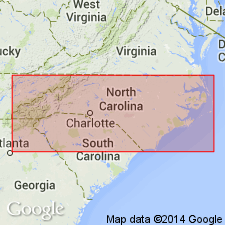
- Usage in publication:
-
- Uwharrie Formation*
- Modifications:
-
- Named
- Dominant lithology:
-
- Tuff
- Rhyolite
- AAPG geologic province:
-
- Piedmont-Blue Ridge province
Summary:
Uwharrie Formation named for mountains in central NC, where unit is best exposed and least metamorphosed. Crops out in belt 41 mi long and as much as 18 mi wide along axis of Troy anticlinorium in Carolina slate belt west of Deep River-Wadesboro Triassic basin. Also appears in areas of anticlinal folds along western border of slate belt in Union Co., central Orange Co., in Durham Co., northwest of Triassic basin, and in southern Person Co. The Uwharrie is composed of felsic tuffs consisting of interbedded lithic, lithic-crystal, and devitrified vitric-crystal tuffs, welded flow tuffs, and rhyolite. Base not known to be exposed. Total thickness is conjectural. If formation has not been repeated by faulting and folding, exposed part is at least 20,000 ft thick. East of Troy anticlinorium unit conformably underlies Efland Formation (new); west of anticlinorium, underlies Tillery Formation (new). Age given as early Paleozoic.
Source: GNU records (USGS DDS-6; Reston GNULEX).
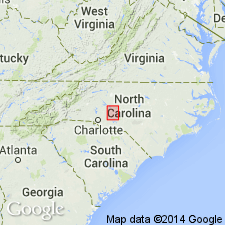
- Usage in publication:
-
- Uwharrie Formation*
- Modifications:
-
- Age modified
- AAPG geologic province:
-
- Piedmont-Blue Ridge province
Summary:
Age of the Uwharrie Formation changed from early Paleozoic to Ordovician(?).
Source: GNU records (USGS DDS-6; Reston GNULEX).
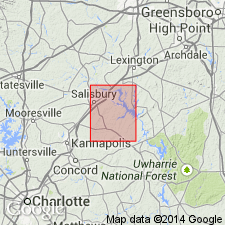
- Usage in publication:
-
- Uwharrie Formation*
- Modifications:
-
- Age modified
- AAPG geologic province:
-
- Piedmont-Blue Ridge province
Summary:
Age of the Uwharrie changed from Ordovician(?) --to-- Cambrian based on Rb-Sr date of 535 +/-50 Ma on rhyolite in Uwharrie Formation.
Source: GNU records (USGS DDS-6; Reston GNULEX).
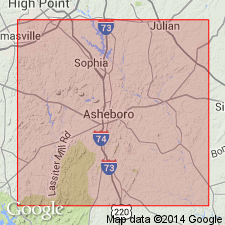
- Usage in publication:
-
- Uwharrie Formation*
- Modifications:
-
- Age modified
- AAPG geologic province:
-
- Piedmont-Blue Ridge province
Summary:
Age of Uwharrie revised from Cambrian to: late Precambrian and (or) Cambrian based on recalculated Rb-Sr date. The 535+/-50 m.y. Rb-Sr whole rock age previously reported from the upper part of the unit was recalculated by Fullagar (1971) as 565+/-50 m.y.
Source: GNU records (USGS DDS-6; Reston GNULEX).
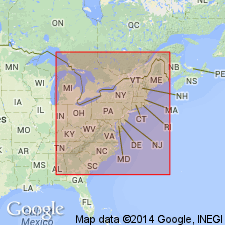
- Usage in publication:
-
- Uwharrie Formation*
- Modifications:
-
- Geochronologic dating
- AAPG geologic province:
-
- Piedmont-Blue Ridge province
Summary:
Felsite near the top of the Uwharrie has a U-Pb discordia age of 584 m.y. Rb-Sr whole rock isochron age of 554+/-50 m.y determined for rhyolite in the Uwharrie.
Source: GNU records (USGS DDS-6; Reston GNULEX).
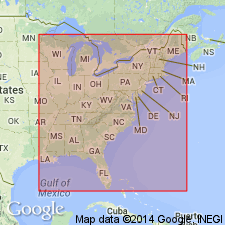
- Usage in publication:
-
- Uwharrie Formation*
- Modifications:
-
- Geochronologic dating
- AAPG geologic province:
-
- Piedmont-Blue Ridge province
Summary:
U-Pb zircon age of 586 +/-10 Ma (Wright and Seiders, 1980) obtained from upper part of bimodal volcanic rocks of Uwharrie Formation indicates deposition in Late Proterozoic time. Uwharrie unconformably overlies 575-Ma Roxboro Granite.
Source: GNU records (USGS DDS-6; Reston GNULEX).
For more information, please contact Nancy Stamm, Geologic Names Committee Secretary.
Asterisk (*) indicates published by U.S. Geological Survey authors.
"No current usage" (†) implies that a name has been abandoned or has fallen into disuse. Former usage and, if known, replacement name given in parentheses ( ).
Slash (/) indicates name conflicts with nomenclatural guidelines (CSN, 1933; ACSN, 1961, 1970; NACSN, 1983, 2005, 2021). May be explained within brackets ([ ]).

